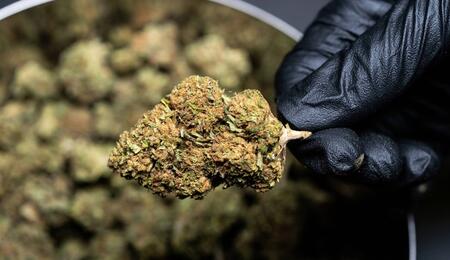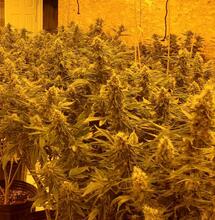How to Get Yourself Started with Growing Cannabis Plants Indoors

For everyone who wants to try out cultivating their own weed. Homegrown is always the best and with a little care and attention, you'll eventually learn to grow the best plants.
Sick and tired of giving too much money for weed? Perhaps you have a bigger garage, spare room, or even a backyard, or simply you want to try how much of a farmer you are? No matter the reason, growing marijuana indoors gives you control that you just don’t get from nature.
Not to discourage you at the very beginning, for indoor cultivation, you need a commitment. And what you don’t get from nature, you have to provide by yourself: enough light, water, oxygen, nutrients, and CO2. Scary? Of course not!
Cultivation conditions
You are the master here. No storms or excessive sunlight can destroy your precious crops. You are controlling the temperature, ventilation, and CO2 in order to create an ideal environment for your product that will have quality yields. It is really important to keep an eye on the hygienic protocols and standards, especially if you are doing this for medical purposes. Unlike outdoor growing, your plants here are not endangered by grazing animals that can potentially destroy your crop. Moreover, growing indoors saves you from judgmental neighbors and potential thieves.
Multiple harvests
The ideal conditions for plants allow a maximum number of annual harvests in divergent vegetative and generative phases. You have the ability to define the size of your plants, the time of the flowering, and therefore the harvest time, and this gives you also the possibility to begin another batch right in your rhythm, no matter the season. Probably this was convincing enough, so let’s have a look at the technical issues right now.
What exactly is necessary to grow weed indoors?
Cannabis plants tucked inside, under the dim light.
Growing space
Basement, garage, closed balcony, anything will do. The essential for your plants it’s not to be moved, to be somewhere where it is cool and dry and it would be ideal if they are next to a window for extra air from the outside. Don’t forget the smell, especially when flowering. Keep it small and simple at the beginning, and remember that cannabis plants do double in size in the flowering phase, so give them their much-needed space for extra quality.
Always have in mind that the basement usually requires a dehumidifier or heater to stabilize the environment. Too hot it’s not the best solution because you will need to add extra fans or an AC to cool the plants down. For optimal results, it is preferable to have lights on during the night when outside is cooler temperatures and leave the lights off during the day when it’s hot.
Grow lights
Weed plants usually need 18 hours of light a day when in the vegetative stage and 12 hours a day when flowering. However, light strategies might vary depending on the strain. You can make use of several different types of lights. Each type comes with varying efficiency, and it can reflect on your electricity bill the bigger the grow room. HID (high-intensity discharge) lamps are more affordable than the LED lighting, which is very effective but expensive.
Metal halide (MH) on the other hand produces blueish-white light and is intended for vegetative growth. And high-pressure sodium (HPS) is more on the red-orange end of the spectrum and is used during the flowering stage. The choice is all yours! For best results, plug the right light to set it to shine for the needed time.
Humidity and fans
The temperature should be warm enough to where you grow your cannabis plants. Between 70–85°F (20-30°C) would be some optimal range for daytime. At night, cannabis can make use of slightly cooler temperatures but never too cold. Like 62-68°F (17-20°C) should be okay. Still, depending on whether you are growing a specific strain, you may want to check if the optimal temperature range for that strain is somewhat different and what are the best practices among other growers. As you take care of temperatures, you also need to take care of room humidity. The flowing of fresh air for plants is essential to the process of photosynthesis, and it can be obtained by setting an exhaust fan near the top of the space to suck out warm air.
On the opposite side, you need to provide a port or passive fan to give in cool air, so the complete air exchange should happen approximately every minute. The lack of proper airflow could perform changes in humidity or develop pockets of CO2 depletion, leading to nutrient lockout and even pest infestation, mold, or mildew. A humidity level around 50% should be okay. 60% gets you closer to the risk of mold. But with a well-ventilated room, you are one step away from mold even with higher room humidity.
Then again, some strains will fare better in more humid conditions and others less. You can position your fans to the walls or sticks and use fans that have oscillation capabilities. Consider investing in a dehumidifier—also known as “dehueys” to address humidity issues. Fans, lights, dehumidifiers, they suck a lot of electricity which is one of the disadvantages of growing indoors.
Glass jar with ground weed. Proper way to store it once you've grown it.
Water and nutrients
We don’t need to emphasize the importance of watering but beware of overwatering too. Just observe the leaves of the plants to “tell” if they are a bit thirsty. Or perform a simple test on the soil, inching your finger in to see if it's moist and to determine if the plant needs water now or later. Usually, a half-liter or liter of water per gallon every five to seven days slowly and attentively will satisfy the needs.
For the excess water, provide a saucer beneath your pot, and of course, the bamboo stakes and twist ties are mandatory here if you want your plants to straighten up. Cannabis plants also have their pH levels — specifically, between 5.9 and 6.5. It is preferable to use a pH meter to test the water's pH level and a TDS meter to test the nutrient levels in plants every second week during the growing cycle. Check this handy guide on nutrients for your cannabis plants.
Harvesting and storage
Yes, we are almost there! If you are not quite sure when your weed is ready for harvesting, just look at the tiny little bulbous portions called trichomes to change their opaque white color into a brownish amber. First, pick up most of the leaves manually, then wait two days before cutting. It is not a great philosophy, but every great weed farmer should cut down the plant with a PVC pipe cutter and then determine if you want to cut on branches.
The next procedure is waiting for ten days to dry in a dark, non-lit space that’s approximately 56 degrees with a humidity level of around 60. If the plant is wrinkled and sharp, it is properly dried. Invest in storage and quality jars too. The jar should be filled about 75 percent, and a four-ounce jar will keep an eighth of an ounce of dried weed (or about three and a half grams) and an eight-ounce jar—about a quarter (about seven grams).
This is the second step, or the secondary drying phase, that lasts from 5 to 10 days, and it is important to open and move the fellas of the bottom layer to dry evenly. The moisture level should be between 9 and 12 percent, and you can keep them long-term in a temperature-controlled space. You can label the plants, and congratulations—you are a magic maker now!



